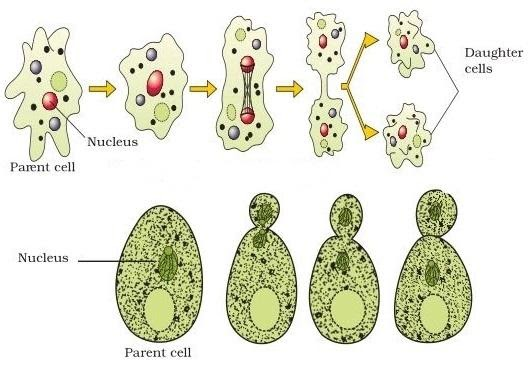
From the picture, identify the methods of asexual reproduction in animals?

A. Binary fission, budding
B. Vegetative propagation
C. Both A and B
D. Asexual reproduction does not take place in animals

Answer
397.8k+ views
Hint: Asexual reproduction is a type of reproduction where fusion of gametes does not take place. There is also no change in the number of chromosomes. Asexual reproduction is the main type of reproduction that take place in single celled organisms such as archaea and bacteria. Eukaryotic organisms such as plants, animals, and fungi can also reproduce asexually.
Complete answer:
Option A Binary fission, budding: In binary fission, the parent cell is split into two new daughter cells. During this process, division and duplication of the parent’s genetic matter into two parts occur. In budding a new organism is developed from a part of the parent’s body. The bud detaches to develop into a new organism. In the given diagram binary fission and budding is observed.
Option A is correct.
Option B vegetative propagation: Vegetative propagation is a reproduction method that occurs exclusively in plants and in some animals. It occurs through fragmentation and regeneration of specific vegetative parts of the organism. In the given diagram vegetative propagation is not present.
Option B is incorrect.
Option C both A and B: This option is incorrect because option B which is vegetative propagation is not given in the diagram.
Option C is incorrect.
Option D Asexual reproduction does not take place in multicellular animals: This statement is wrong because animals does reproduce asexually through methods like binary fission, budding, regeneration, fragmentation etc.
Option D is incorrect.
Hence, Option A. Binary fission, budding is the correct answer.
Note:
The animals also reproduce exclusively through sexual reproduction. In this method, a haploid male gamete fuses with a haploid female gamete to form a diploid zygote. The zygote divides through mitosis and differentiates into an embryo. The resulting organism is diploid in nature. Sexual reproduction leads to variation and diversity which is the main advantage of this method.
Complete answer:
Option A Binary fission, budding: In binary fission, the parent cell is split into two new daughter cells. During this process, division and duplication of the parent’s genetic matter into two parts occur. In budding a new organism is developed from a part of the parent’s body. The bud detaches to develop into a new organism. In the given diagram binary fission and budding is observed.
Option A is correct.
Option B vegetative propagation: Vegetative propagation is a reproduction method that occurs exclusively in plants and in some animals. It occurs through fragmentation and regeneration of specific vegetative parts of the organism. In the given diagram vegetative propagation is not present.
Option B is incorrect.
Option C both A and B: This option is incorrect because option B which is vegetative propagation is not given in the diagram.
Option C is incorrect.
Option D Asexual reproduction does not take place in multicellular animals: This statement is wrong because animals does reproduce asexually through methods like binary fission, budding, regeneration, fragmentation etc.
Option D is incorrect.
Hence, Option A. Binary fission, budding is the correct answer.
Note:
The animals also reproduce exclusively through sexual reproduction. In this method, a haploid male gamete fuses with a haploid female gamete to form a diploid zygote. The zygote divides through mitosis and differentiates into an embryo. The resulting organism is diploid in nature. Sexual reproduction leads to variation and diversity which is the main advantage of this method.
Recently Updated Pages
Questions & Answers - Ask your doubts

Master Class 11 Accountancy: Engaging Questions & Answers for Success

Master Class 11 Science: Engaging Questions & Answers for Success

Full Form of IASDMIPSIFSIRSPOLICE class 7 social science CBSE

In case of conflict between fundamental rights of citizens class 7 social science CBSE

Can anyone list 10 advantages and disadvantages of friction

Trending doubts
Fill the blanks with the suitable prepositions 1 The class 9 english CBSE

How do you graph the function fx 4x class 9 maths CBSE

Difference Between Plant Cell and Animal Cell

What is pollution? How many types of pollution? Define it

What is the color of ferrous sulphate crystals? How does this color change after heating? Name the products formed on strongly heating ferrous sulphate crystals. What type of chemical reaction occurs in this type of change.

Which places in India experience sunrise first and class 9 social science CBSE




